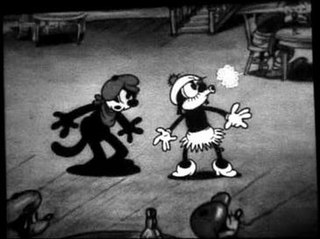Related Research Articles

George Joseph Herriman III was an American cartoonist best known for the comic strip Krazy Kat (1913–1944). More influential than popular, Krazy Kat had an appreciative audience among those in the arts. Gilbert Seldes' article "The Krazy Kat Who Walks by Himself" was the earliest example of a critic from the high arts giving serious attention to a comic strip. The Comics Journal placed the strip first on its list of the greatest comics of the 20th century. Herriman's work has been a primary influence on cartoonists such as Elzie C. Segar, Will Eisner, Charles M. Schulz, Robert Crumb, Art Spiegelman, Bill Watterson, and Chris Ware.
Shoot boxing, commonly written as Shootboxing, is a combat sport.

Robert "Rocky" Balboa is a fictional character and the titular protagonist of the Rocky franchise. The character was created by Sylvester Stallone, who has also portrayed him in eight of the nine films in the franchise. He is depicted as a working class or poor Italian-American from the slums of Philadelphia who started out as a club fighter and "enforcer" for a local Philly Mafia loan shark. He is portrayed as overcoming the obstacles that had occurred in his life and in his career as a professional boxer.

Apollo Creed is a fictional character from the Rocky franchise, portrayed by Carl Weathers. He appears in the first four Rocky films, serving as the main antagonist in Rocky and Rocky II, and later becoming one of the protagonists in Rocky III and Rocky IV. Sylvester Stallone, the writer and star of the Rocky series, stated that Jack Johnson was the inspiration for the character of Apollo Creed. Protagonist Rocky Balboa—Creed's rival in Rocky and Rocky II—faces underdog odds, but he views Creed with respect, pointedly refusing the prodding of a reporter to trash-talk Apollo Creed, even after he publicly taunts Balboa by remarking "he's great."

Krazy Kat is an American newspaper comic strip, created by cartoonist George Herriman, which ran from 1913 to 1944. It first appeared in the New York Evening Journal, whose owner, William Randolph Hearst, was a major booster for the strip throughout its run. The characters had been introduced previously in a side strip with Herriman's earlier creation, The Dingbat Family, after earlier appearances in the Herriman comic strip Baron Bean. The phrase "Krazy Kat" originated there, said by the mouse by way of describing the cat. Set in a dreamlike portrayal of Herriman's vacation home of Coconino County, Arizona, KrazyKat's mixture of offbeat surrealism, innocent playfulness and poetic, idiosyncratic language has made it a favorite of comics aficionados and art critics for more than 80 years.
Seeing Stars is a 1932 short animated film distributed by Columbia Pictures, and features Krazy Kat. Different from most shorts of the series, the cartoon features celebrities in their animated forms.

The Apache Kid is a 1930 cartoon short distributed by Columbia Pictures and features Krazy Kat. The film is the character's 149th film.
Lil' Ainjil is a 1936 short animated film distributed by Columbia Pictures, and features Krazy Kat.
Love's Labor Lost is a 1920 short, animated film by Bray Productions and is one of the silent Krazy Kat cartoons. The film's title references a play by William Shakespeare.

Rail Rode is a 1927 silent short animated film released by Paramount featuring Krazy Kat.
The Mouse Exterminator is a 1940 short animated film in the Phantasies series, produced and distributed by Columbia Pictures. It marks the final theatrical appearance of Krazy Kat, the title character from George Herriman's comic strip.
Krazy Kat and Ignatz Mouse: A Duet, He Made Me Love Him, also simply known as A Duet, is a 1916 silent short animated film featuring Krazy Kat. It is among the earliest cartoons to feature Krazy who earlier achieved modest success through comic strips.
Krazy Kat & Ignatz Mouse Discuss the Letter 'G' is a 1916 silent short animated film featuring the comic strip character Krazy Kat. As with other animated shorts at the time, it was featured as an extra along with news reports that were released on film.
Krazy's Waterloo is a 1934 short theatrical cartoon by Columbia Pictures, and one of the many films featuring Krazy Kat. The film is loosely based on the times of French emperor Napoleon Bonaparte. It is also perhaps the only film where Krazy is cast as someone other than himself.
Jazz Rhythm is a 1930 short animated film distributed by Columbia Pictures. The film is part of a series featuring the comic strip character Krazy Kat.
The Great Cheese Robbery is a silent short animated film made by Bray Productions featuring Krazy Kat. It marks the first Krazy film produced by Bray after the International Film Service (IFS) ended its run in making films in the series.
A Family Affair is a silent short animated film by Bray Productions featuring Krazy Kat. It is the sixth Krazy short produced by the studio.
The Awful Spook is a silent short animated film created by the Bray Studio, featuring Krazy Kat.
The Dingbat Family is a comic strip by American cartoonist George Herriman that ran from June 20, 1910, to January 4, 1916. It introduced Herriman's most famous pair of characters: Krazy Kat and Ignatz Mouse, who later featured in Herriman's best-known strip Krazy Kat (1913–1944).
Events in 1916 in animation.
References
- ↑ Lenburg, Jeff (1999). The Encyclopedia of Animated Cartoons. Checkmark Books. pp. 34–35. ISBN 0-8160-3831-7 . Retrieved June 6, 2020.